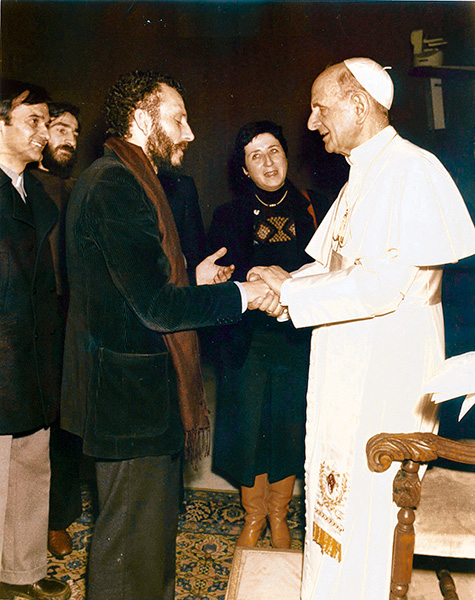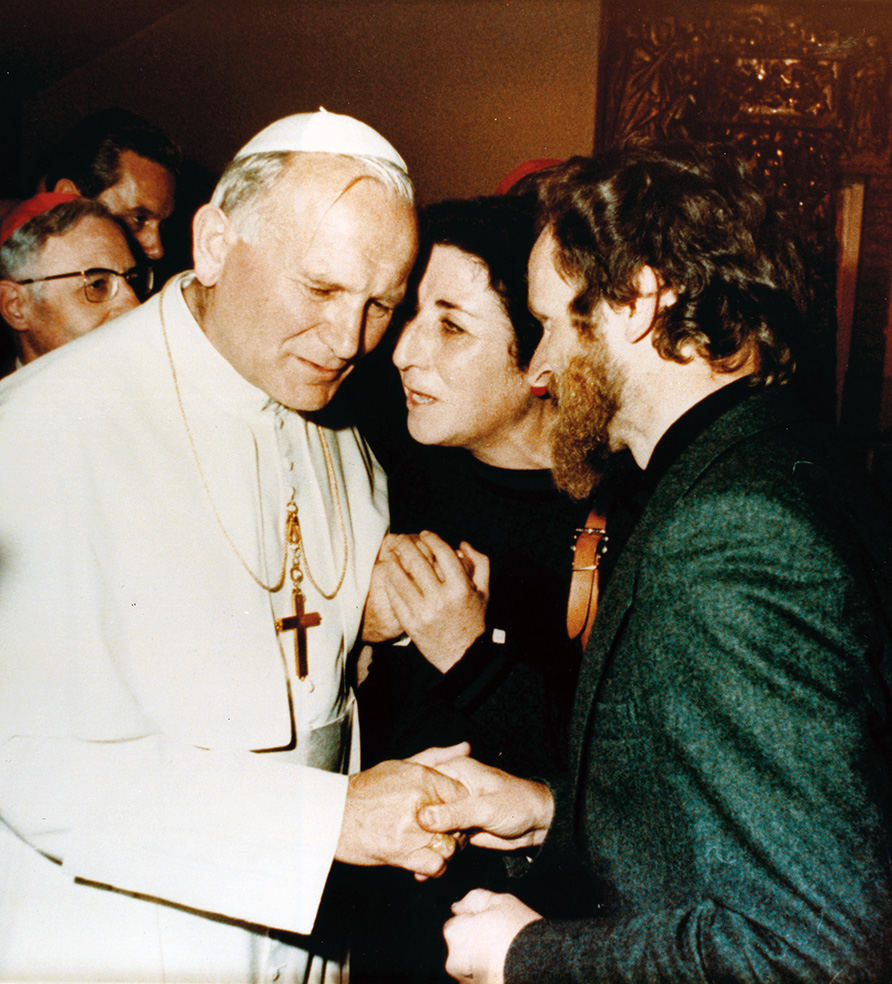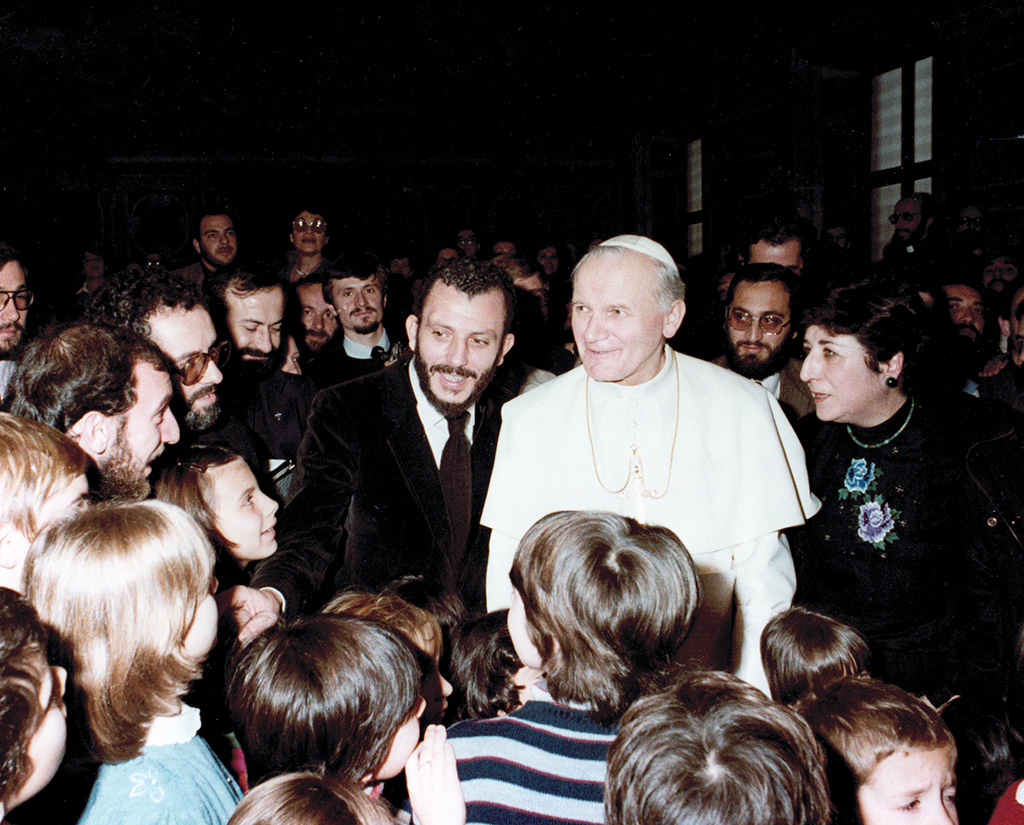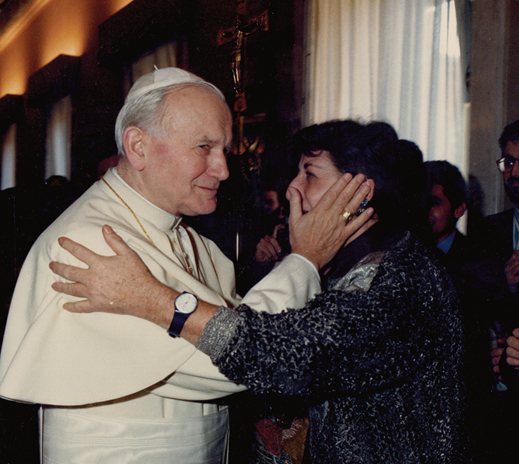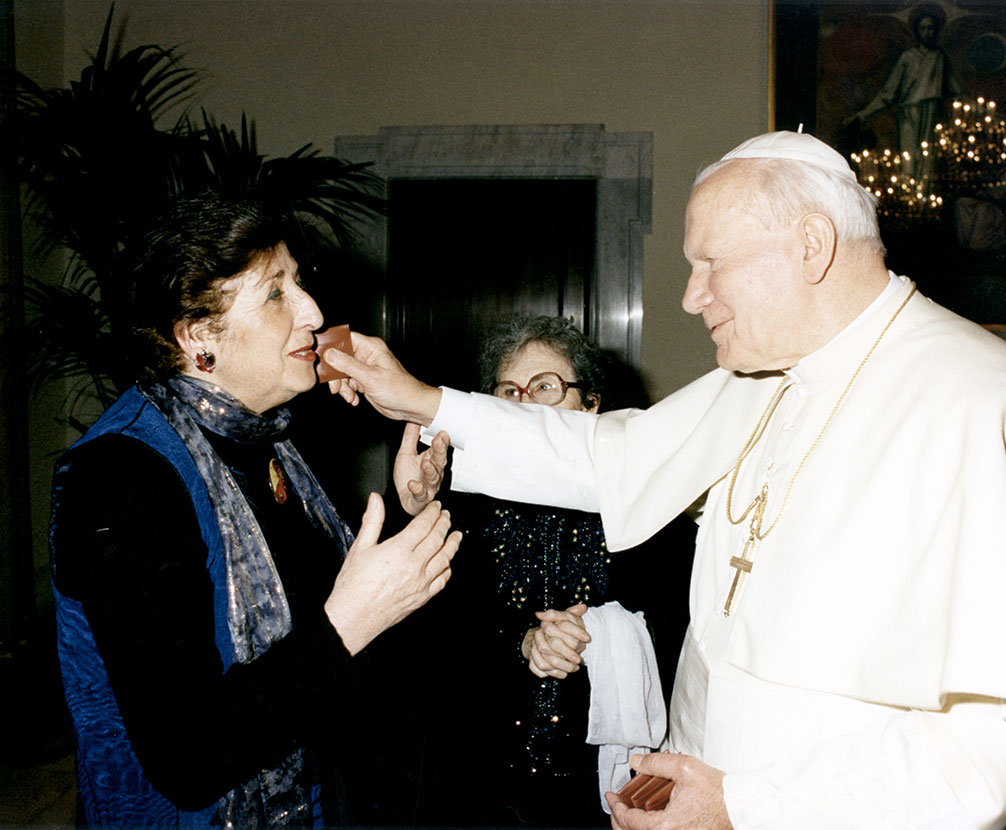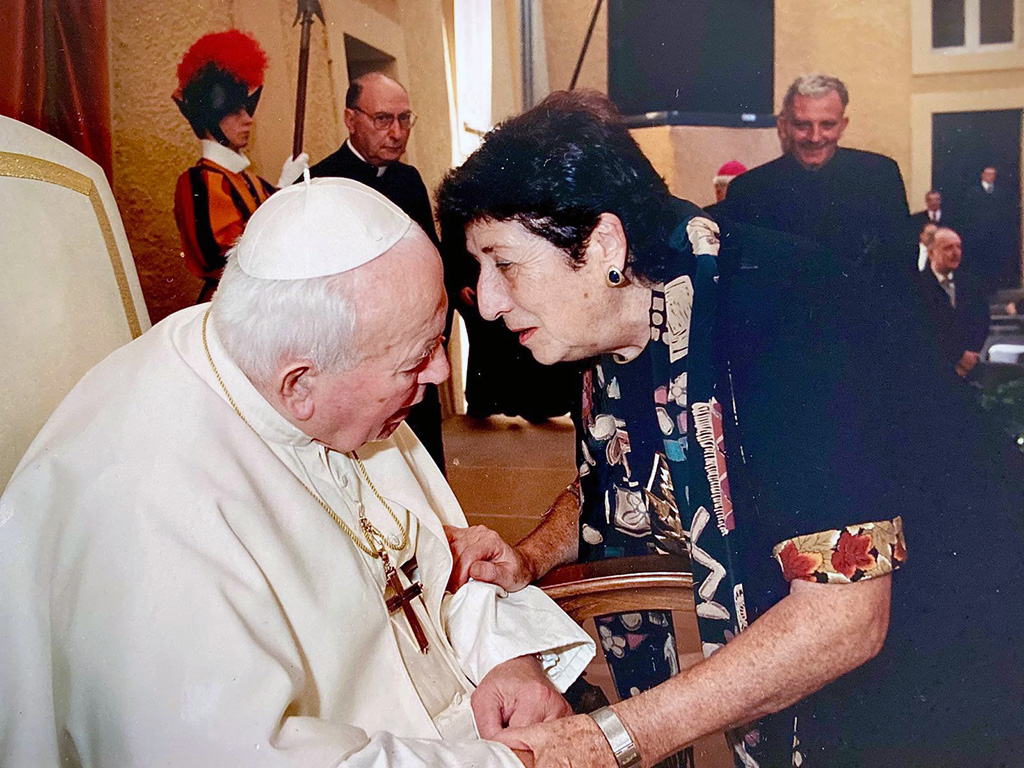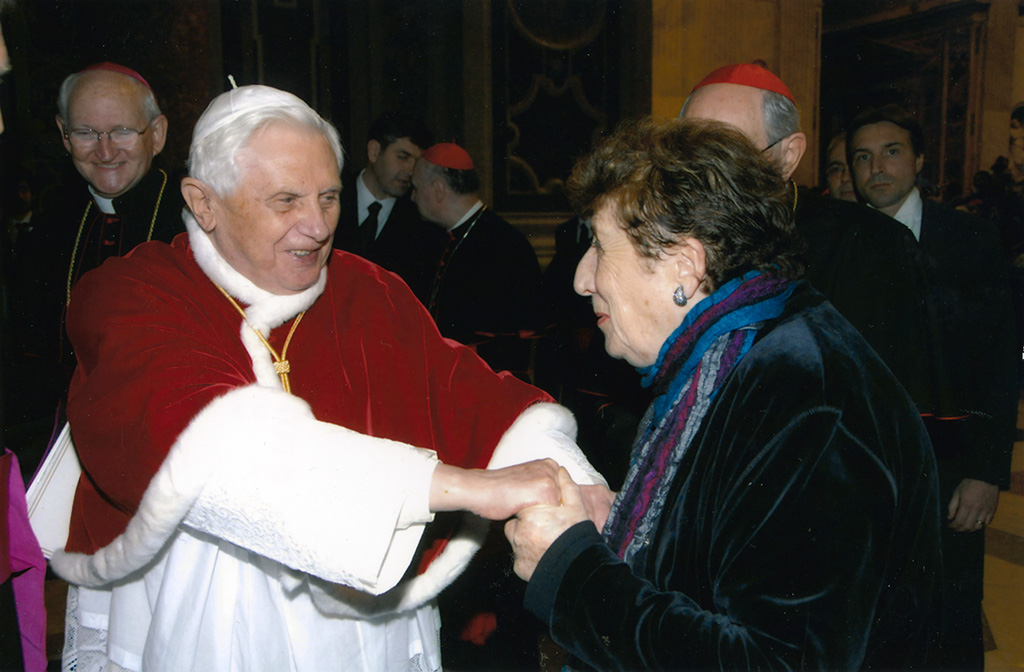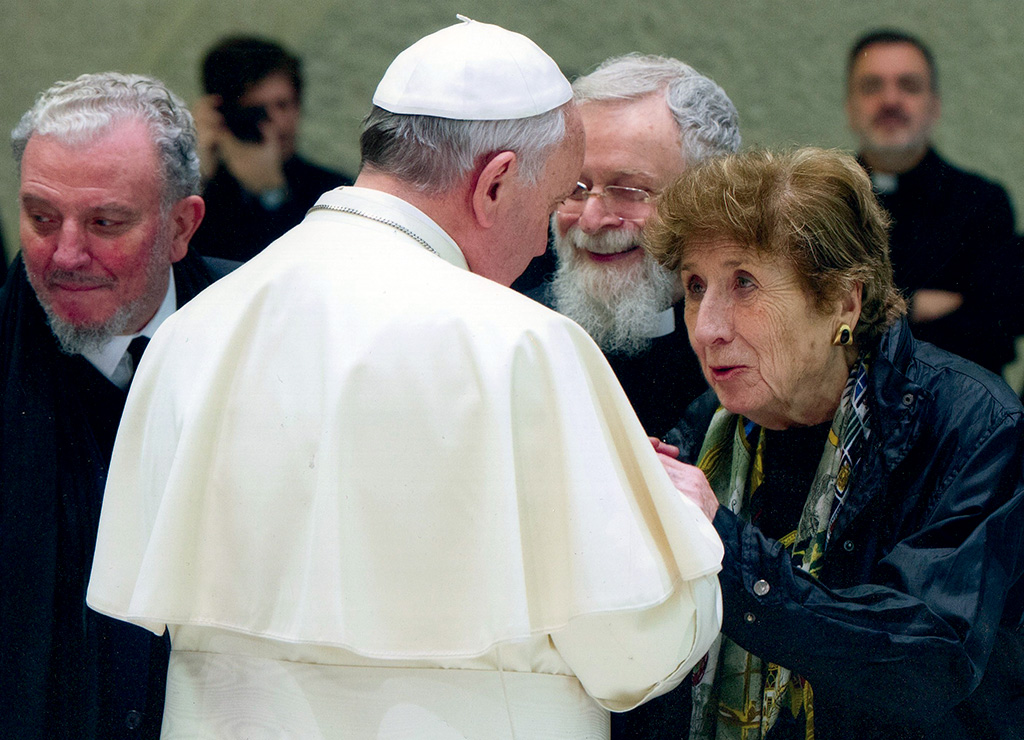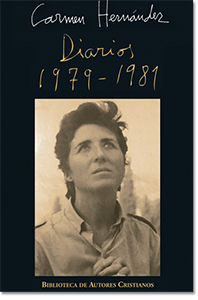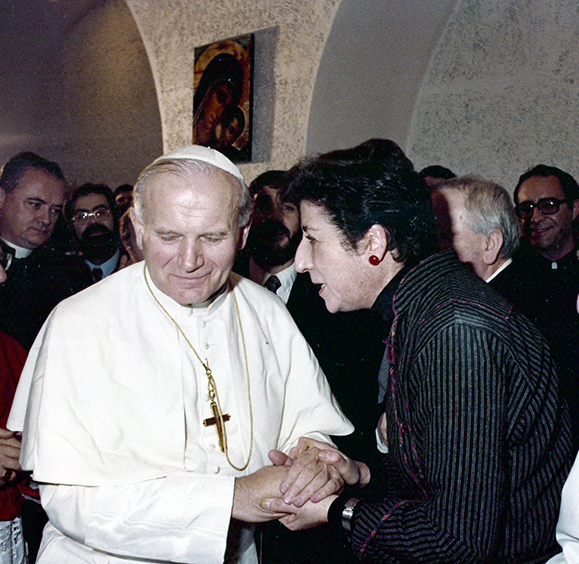
Speech by Kiko Argüello
Good evening to all,
Greetings to D. Carlos Osoro, Cardinal-Archbishop of Madrid.
Cardinal D. Antonio María Rouco, Archbishop Emeritus of Madrid.
Cardinal Paolo Romeo, Archbishop Emeritus of Palermo.
To the archbishops, bishops and episcopal vicars present here.
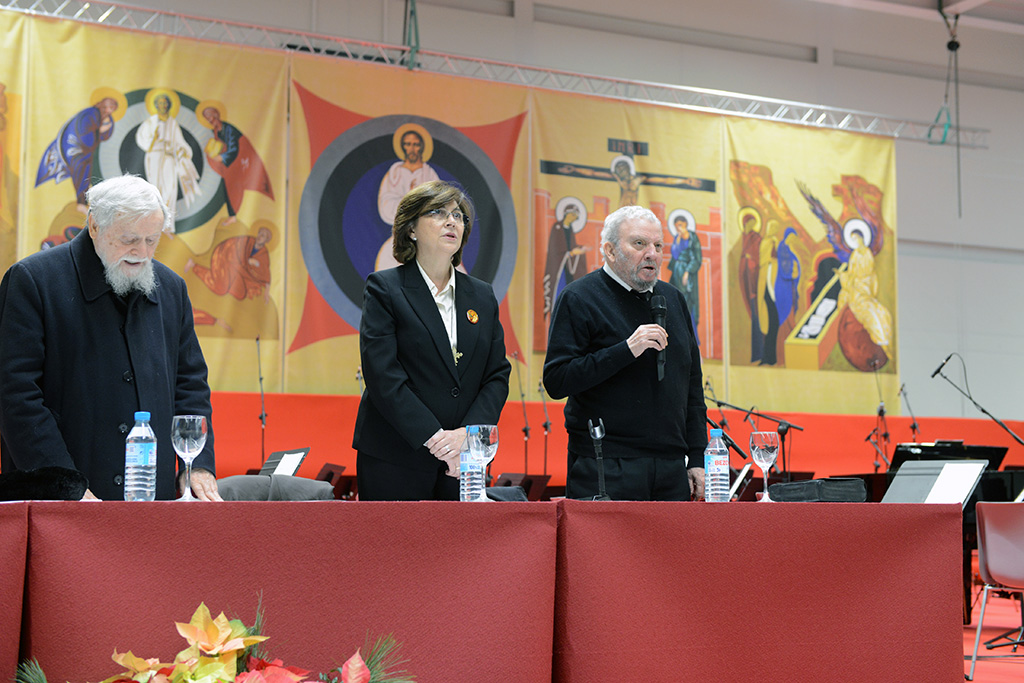
To the Mother General of the Missionary Sisters of Jesus Christ and her councilors: what a joy your presence gives us in this event, sisters!
To the Rector of the University, Mr. Daniel Sada, the Deans of the Faculties and professors.
To the Neocatechumenal communities catechized by Carmen and me in Madrid, Zamora, Barcelona, Rome, Florence, Ivrea and Paris.
To the itinerant catechists, to the rectors and formators of the Redemptoris Mater seminaries, to the priests and to all of you present here. I send my affectionate greetings to the many brothers and sisters of the Way who are following the event on the internet.
We are grateful for the many letters received from archbishops and bishops from the five continents who, unable to attend this event, share their joy with our brothers and sisters of the Way and join us with their prayers.
I would like to read a few words from Cardinal Farrell, Prefect of the Dicastery for Laity, Family and Life, who also sent us a letter:
Dear Kiko, Fr. Mario y María Ascensión,
I thank you for the invitation you have sent me to participate in the official Opening Ceremony of the Cause of beatification and canonization of Carmen Hernández, which will take place, God willing, at the University Francisco de Vitoria in Madrid.
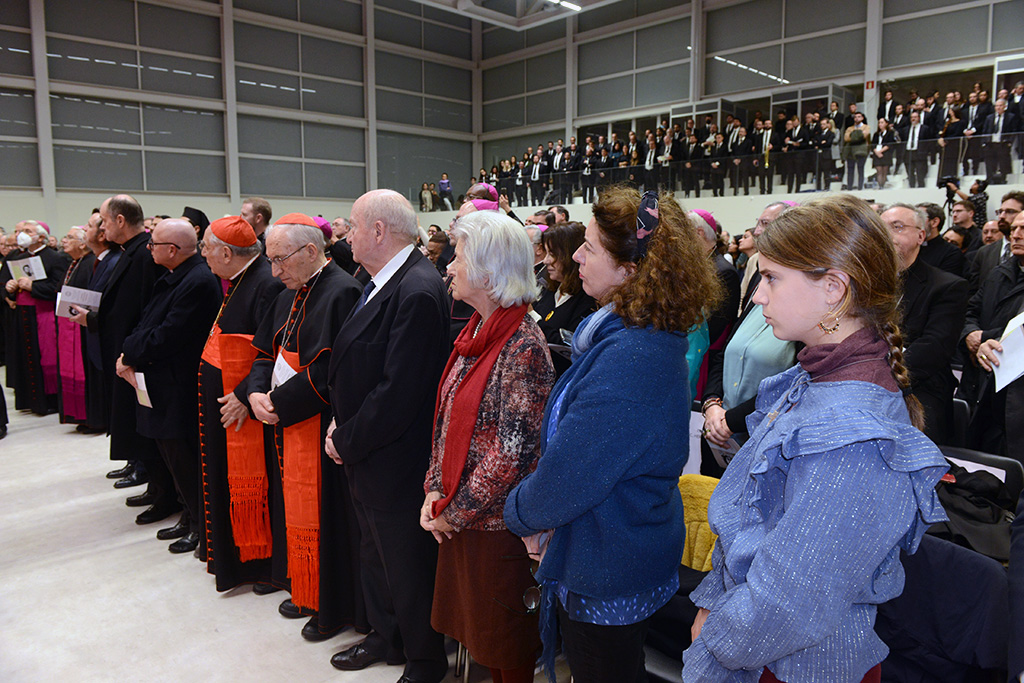
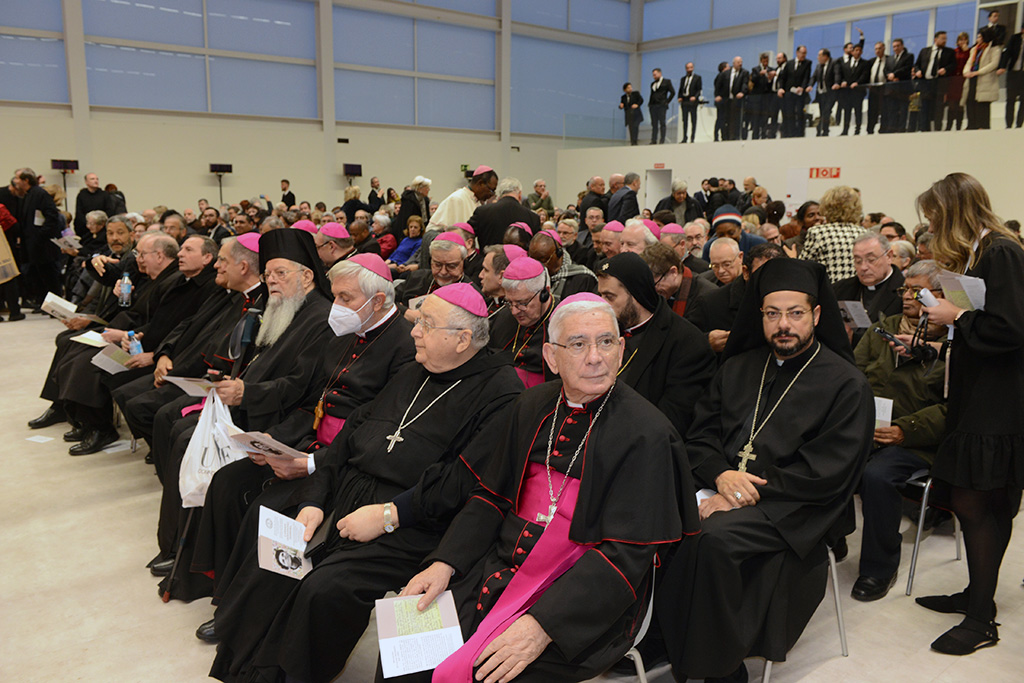
I am happy to know that the petition for the Opening of the Cause of Carmen’s canonization has been accepted and I join in your joy and your thanksgiving to the Lord. Unfortunately, due to commitments already fixed in the agenda for that period, I am unable to be with you that day in Madrid.
I assure you, however, of my remembrance before the Lord so that Carmen’s life, her witness of faith, her dedication to the end to bring the proclamation of the Gospel everywhere, may continue to be a model of reference for all of you and for the whole Church.
Renewing my gratitude to you and hoping that there may be other occasions for us to meet, I greet you cordially in the Lord.
Cardinal Kevin Farrell. Prefect of the Dicastery for Laity, Family and Life.
I, personally, am very happy that this day has come when the Church begins the diocesan phase of the Cause of Beatification and Canonization of Carmen Hernández. I thank Cardinal Carlos Osoro, Archbishop of Madrid, for initiating the investigation into Carmen’s life, virtues and reputation for holiness.
The Lord has united Carmen and me for 52 years in a marvelous mission of evangelization – which began in this diocese of Madrid – as a fruit of the Council.

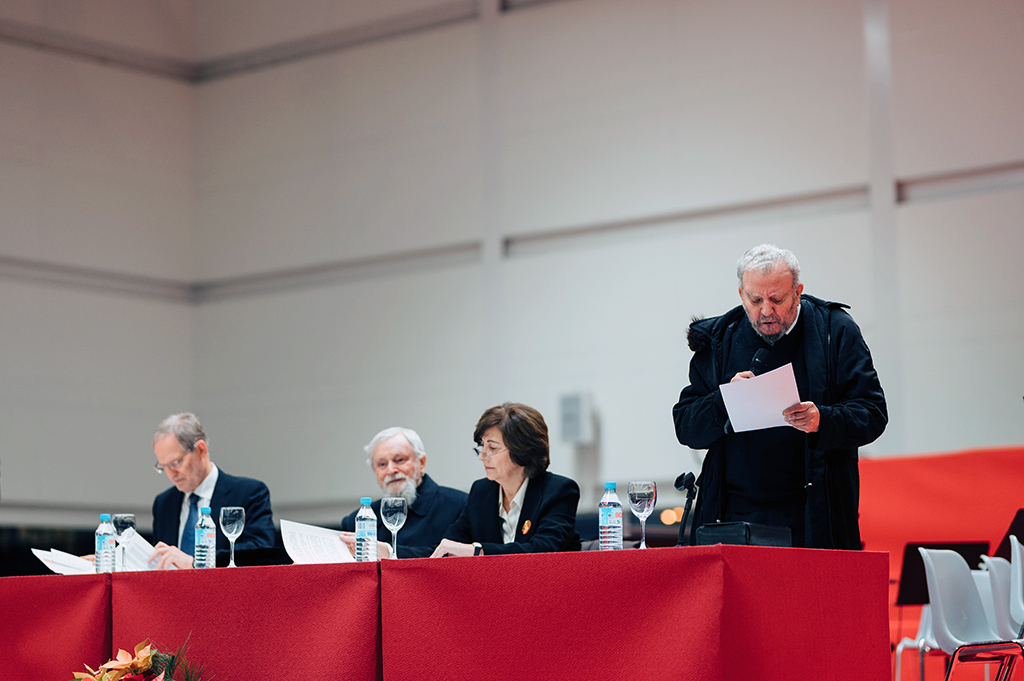
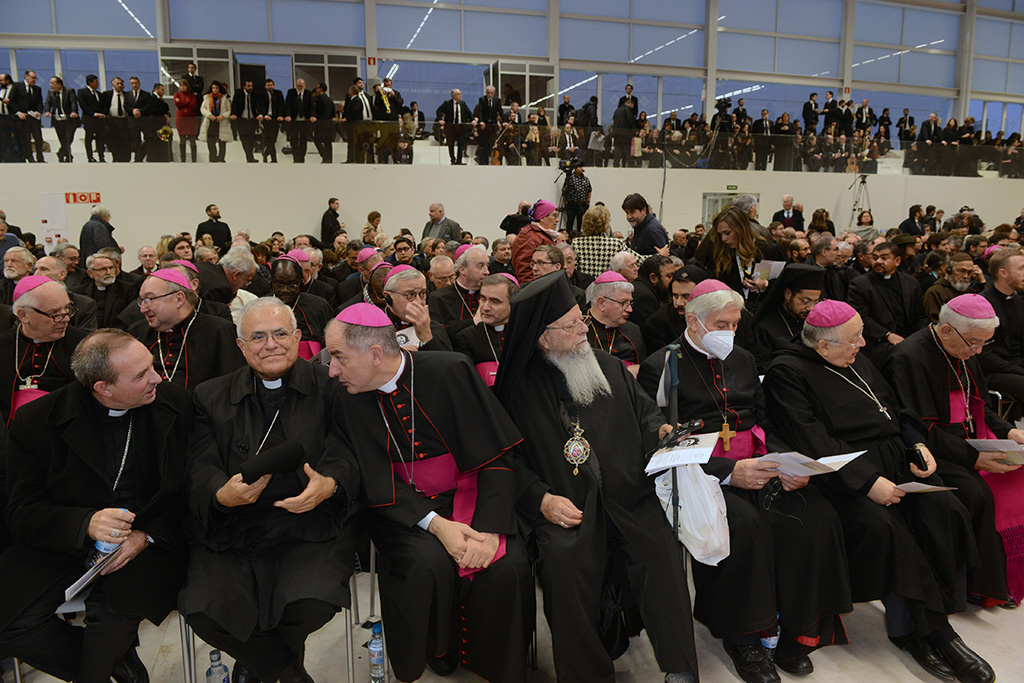
I feel it is a providential fact that the opening of the Cause coincides precisely with the year that commemorates the 60th anniversary of the inauguration of the Second Vatican Council, because Carmen gave her life to bring the Council to the parishes, through a Christian Initiation, at the service of the bishops, which is called the Neocatechumenal Way.
It is surprising to see this history with facts and people; a work not done at a work table but by the action of the Holy Spirit. What was being elaborated in writing at the Second Vatican Council, we saw it being realized with the poor in the shantytowns of Palomeras by the work of the Holy Spirit. There we saw the appearance of the Lord creating forgiveness, love, communion, Christian community! Both Carmen and I have been witnesses of God’s presence in evangelization, witnesses of God’s action in the Church of the Second Vatican Council. We had no preconceived plans or ideas. For more than 50 years we have been able to witness that God is alive in His Church.
Carmen, following in the footsteps of St. Francis Xavier (whose feast we celebrated yesterday), never thought of staying in Spain, because it was like a failure of her missionary ideal. But God wanted us to meet in Madrid, in the shantytown of Palomeras Altas. We met in 1964, on his return from his historic pilgrimage to the Holy Land. I had gone to live in a shack with the poor of Palomeras.
There Carmen got to know the community of the brothers who met in my shack and was very impressed by their response to the Word of God. She decided to stay and live with us and we built her a shack.
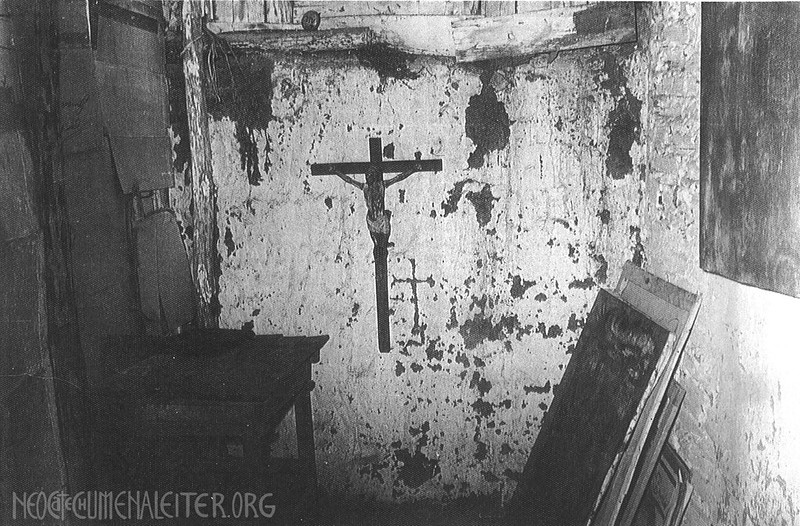
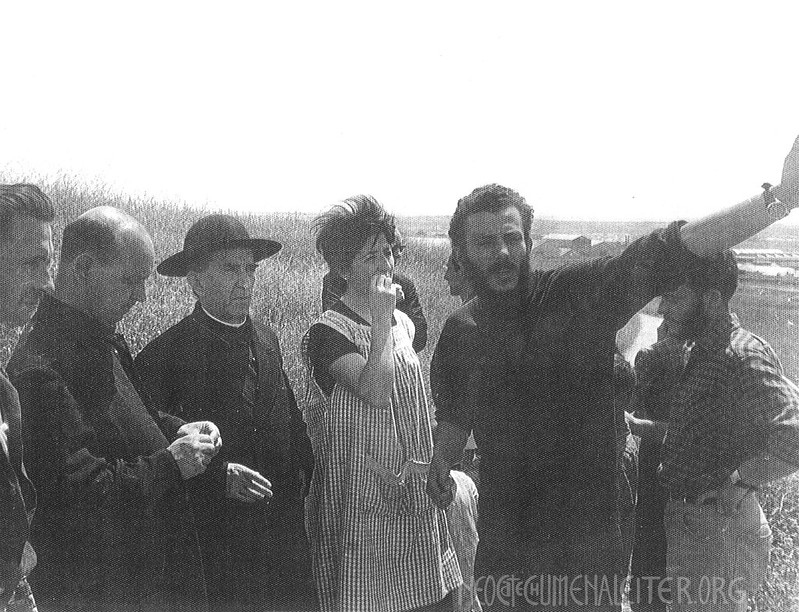
Carmen saw the presence of Jesus Christ, who comes to save sinners, to fulfill the mystery of Easter and to create communion among the poor: Jesus Christ gave himself as gratuitous love for every person.
All this that God allowed, His presence in Palomeras, was like a fertile land that God had prepared to put inside the Church. What God made us experience in the midst of a poor world, the Holy Spirit had prepared for his Church.
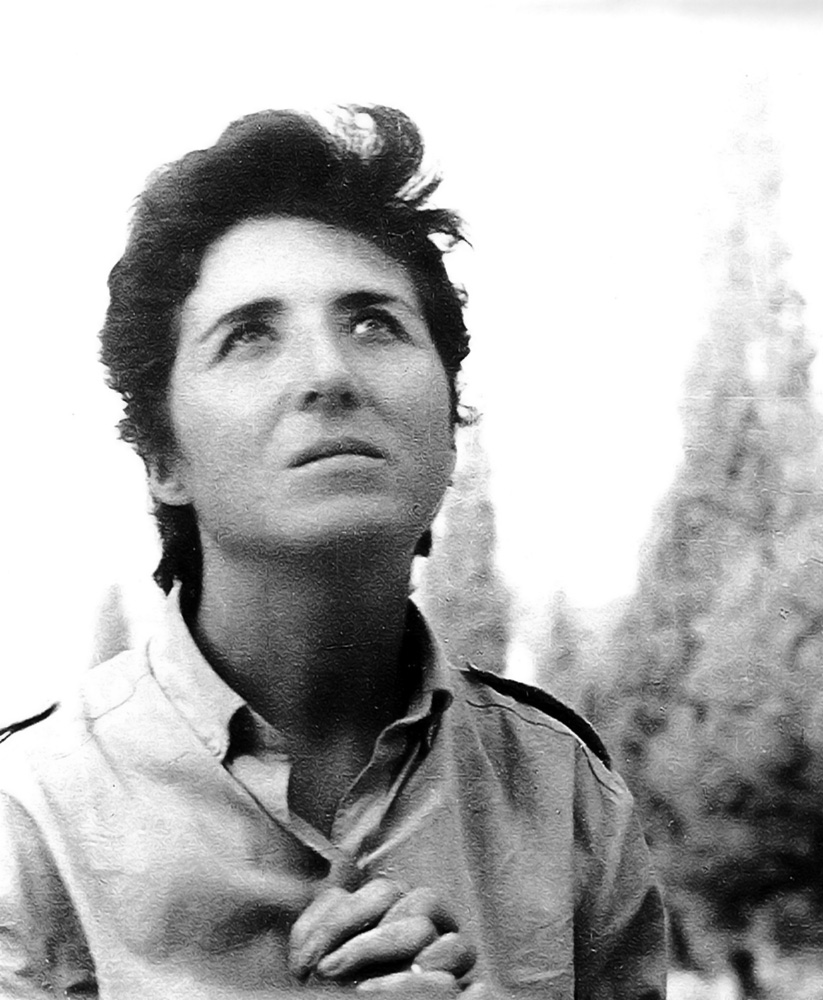
The providential presence of the Archbishop of Madrid in the shantytown was what determined Carmen’s definitive collaboration with me. If it had not been for D. Casimiro Morcillo, we would not have gone to the parishes. He was also the one who opened the doors for us in Italy. Carmen saw in the Archbishop the presence of the Church and completely changed her attitude towards me. With Morcillo’s presence, she saw the promise God had made to her in Israel come true.
When Carmen was in Israel, she often wondered what her mission in the Church was and thought that she had to found a missionary congregation. In Ein Karen, she had the absolute certainty, like a vision, that God wanted her to do something for the universal Church, that it was not about founding a congregation.
I tell you this so that you can see, as a great mystery of the Lord, the collaboration between Carmen and me.
It was very hard for me to accept Carmen, until the Lord told me interiorly that Carmen was a great grace, that there was someone next to me who would constantly tell me the truth, that God had brought her with a mission. So I accepted Carmen in faith as someone sent by the Lord. I suffered until I realized that she came from God, and from that day on she was a grace for me.
Carmen has been great! An extraordinary woman who has done a lot of good, not only to the brothers of the Neocatechumenal Way but to the whole Church.

Carmen, what a wonderful woman! With a masterful genius of freedom and love for the Church. She never flattered me, she always told me the truth. She was able to stand behind me; always at my side, to help me. She never sought the first place, she never sought the limelight. She had a clear conscience that the mission that God had given her was to support me, to defend me and to correct me, for the good of the Neocatechumenal Way.
For love of the Church and the brothers, she has remained with me for 52 years, even though at times it was difficult for her, but Carmen only cared about doing God’s will, which she saw was to be with me in this Christian Initiation that is the Neocatechumenal Way.
Exceptional woman, truly, with an enormous generosity, she has denied herself to show me, despite the corrections, but she was always behind me, supporting me.
She was an example of liberality, sincerity, speaking freely to everyone; she spoke the truth to the brothers in the communities. And when a brother went away, she called him and looked for him, like a lost sheep, with love.
She was an extraordinary woman, a true prophetess, a true missionary, who lived the faith to a heroic degree, an exceptional woman, very important for the Church, always in prayer, in love with Christ, the Scriptures and Easter, and with an unconditional love for the Pope and the Church.
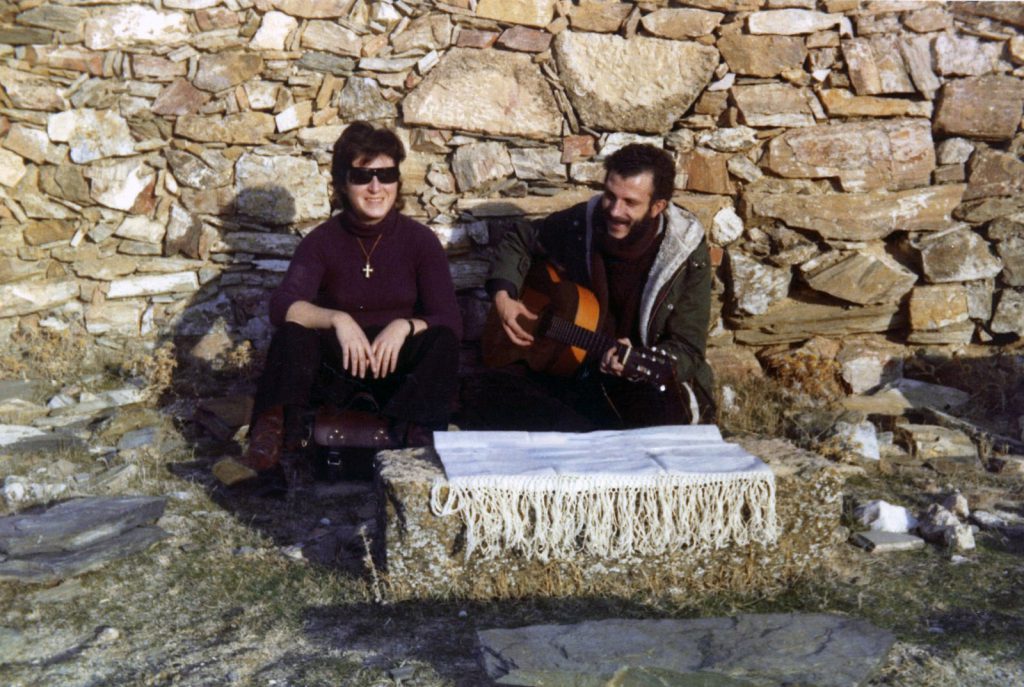
Together we are the initiators of a charism, which the Lord has inspired to help his Church. The words of Pope Francis on the 50th anniversary of the Neocatechumenal Way in 2018, when he said at Tor Vergata: “You are a gift of the Holy Spirit for the Church”, confirm Carmen’s most desired desire: that it be seen that in the Way it is God who is at work, that it is a work of the Holy Spirit in the Church, of which He Himself has called us to be initiators.
In the last audience he granted this year to the International Team of the Way, Pope Francis expressed his joy at the beginning of the opening of the Cause.
I want the Church, in this Cause of canonization that is beginning, to investigate her life, which was often a crucified life, silent and suffering, as “in a dark night”; I also want her virtues to come to light, many of them hidden, many of them heroic. May the Church discern over them.
I thank God for having known her and for having been able to work with her in the “hard work of the Gospel” as St. Paul says.
Carmen, what a great woman, with an exceptional faith! What a great love she had for Christ and his Church!
Thank you.
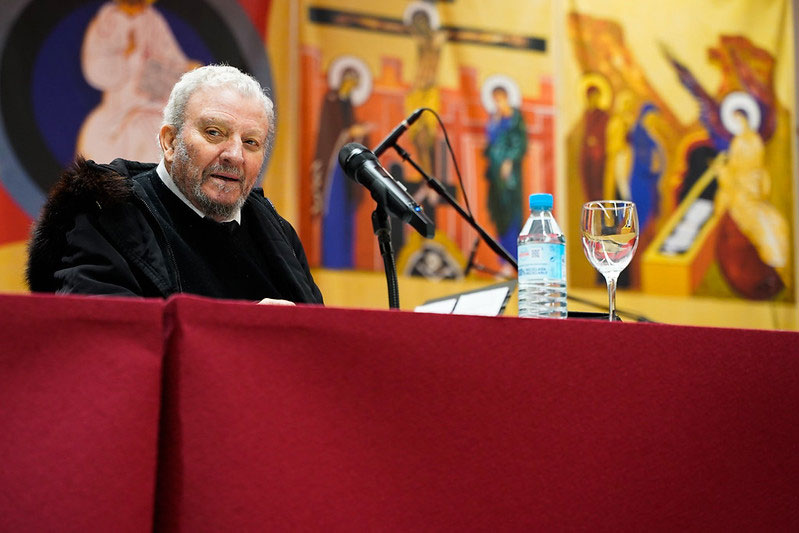
Now we will listen to the Gospel.
This afternoon we would like to present a fragment of the Gospel that deeply touched Carmen: The Transfiguration, which is the marvelous and impressive destiny of human history, and which has already been realized by the Virgin Mary, who is the image not only of the Church but of all humanity.
The Transfiguration will lead this man assumed by Jesus Christ to complete divinization. It is an exaltation to the glory of heaven, to the Ascension. And that can be experienced here, because we Christians, through baptism, are being transformed day by day; even if this body falls apart, we are being transfigured in the face of Jesus Christ. This is the Christian faith that gives light to history, to the future of humanity: the Transfiguration.
Proclamation of the Gospel: Mark 9, 2-8
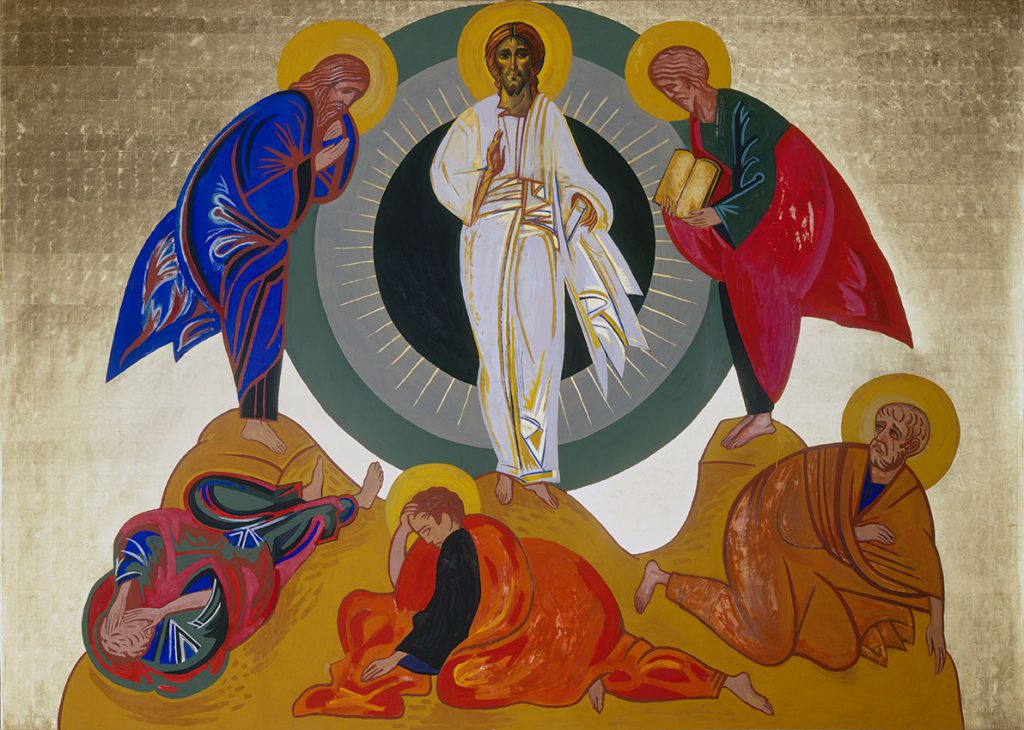
Intervention of Carlos Metola, postulator of the cause.
Carlos Osoro Sierra, Cardinal-Archbishop of Madrid.
Madrid, July 20, 2021. Feast of the Prophet Elijah.
“As the heavens are higher than the earth, so are my ways higher than your ways” (Is 55:9).
The undersigned, Mr. Carlos Metola Gómez, legitimately constituted Diocesan Postulator for the Neocatechumenal Way, the Family of Nazareth Foundation for Itinerant Evangelization of Madrid and the Family of Nazareth Foundation for Itinerant Evangelization of Rome, Actors of the Cause of beatification and canonization of the Servant of God.
MARÍA DEL CARMEN HERNÁNDEZ BARRERA, lay catechist
REQUESTS YOU, ON BEHALF OF THE PLAINTIFFS, AND IN CONFORMITY WITH THE APOSTOLIC CONSTITUTION DIVINUS PERFECTIONIS MAGISTER. E., on behalf of the plaintiffs, and in conformity with the Apostolic Constitution Divinus perfectionis Magister, the Normae Servandae in Inquisitionibus ab Episcopis Faciendis in Causis Sanctorum, and the Instruction Sanctorum Mater on Diocesan or Eparchial Instructional Procedure in the Causes of Saints,
PLEASE begin the diocesan instruction of the Cause of reference in your Archdiocese of Madrid.
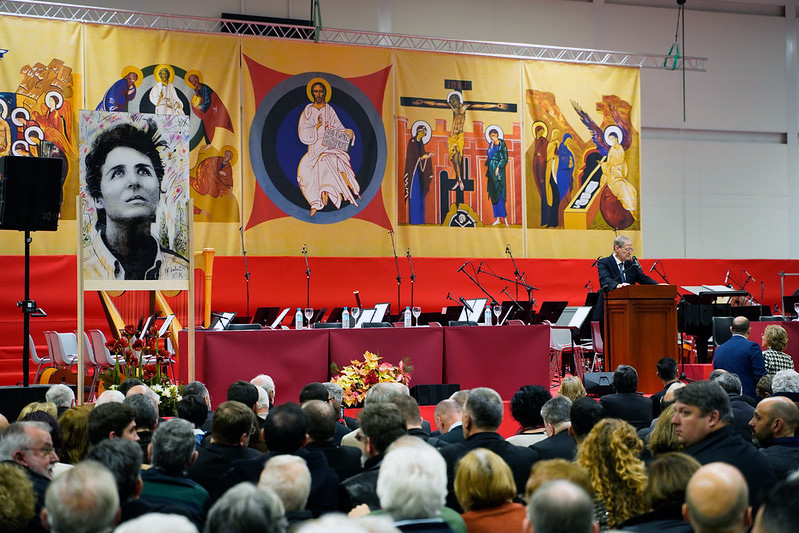
The convocation of the Second Vatican Council by Pope John XXIII in the Constitution Humanae Salutis prophetically stated: “In our day the Church is witnessing a grave crisis of humanity. A new order is in the making, and the Church has before her immense missions, as in the most tragic epochs of history. For what is demanded of the Church today is that she infuse into the veins of present-day humanity the perennial, vital and divine virtue of the Gospel.” [1]
One of the many fruits of this Second Vatican Council is the Neocatechumenal Way, as Pope Paul VI said: “Here are the fruits of the Council! You do after Baptism what the primitive Church did before: the before or after is secondary. The fact is that you look to the authenticity, the fullness, the coherence, the sincerity of the Christian life.” [2]
Pope John Paul II also wrote in the letter Ogniqualvolta: “I recognize the Neocatechumenal Way as an itinerary of Catholic formation valid for society and for the times of today”, and “I strongly desire, therefore, that our brothers in the episcopate, together with their priests, value and help this work for the new evangelization”. [3]
I wanted to begin by quoting these three beloved pontiffs, because of the immense love that the Servant of God Maria del Carmen Hernández Barrera has had throughout her life for the Church and its visible head, the Pope. She, together with Kiko Argüello, have been the initiators of the Neocatechumenal Way, which, as we have pointed out, is one of the fruits of this Second Vatican Council. Carmen Hernandez dedicated all her strength for 52 years to the uninterrupted service of the itinerant proclamation of the Gospel and to be an instrument, as “useless servant” [4] of Christ in the renewal of his Church.
María del Carmen Hernández Barrera was born in Ólvega, province of Soria, on November 24, 1930, to a Catholic family with nine children; she was the fifth, and from an early age she wanted to be a missionary, a vocation that was born and nourished every time the Jesuit missionaries from Tudela (Navarra) came to her school to give talks on the missions. The example of St. Francis Xavier marked her with fire for the rest of her life.
Later, she thought that following Christ meant not pursuing a career in chemistry (which she obtained with brilliant results), thus following the very hopeful life project that her father had set for her, within the thriving family rice industry, but entering the Institute of the Missionary Sisters of Christ Jesus, founded by M. María Camino Sanz Orrio with the invaluable help of the then Archbishop of Pamplona, D. Marcelino Olaechea. She did so in 1954. During the eight years that Carmen was in the Missionary Sisters she received an excellent formation in spirituality, community life and apostolate. Reading her diaries and notes of conscience from these years, it is impressive the love for Jesus that she shows, the phrase that she repeats most often in them is: “My Jesus, I love you! Also astonishing are the numerous very deep spiritual experiences, “quasi mystical”, and of heroic sacrifices, through which the Lord was leading her. Between 1957 and 1960 she studied Religious Sciences at the Sedes Sapientiae Institute in Valencia, with some magnificent professors whom she always mentioned; her grades were brilliant and she completed a Summa cum laude thesis on “The need for Prayer in the thought of Pius XII”. All this instilled in her an enormous love for liturgical prayer, the Eucharist and Sacred Scripture, as actual and necessary presence of Christ in her daily life.
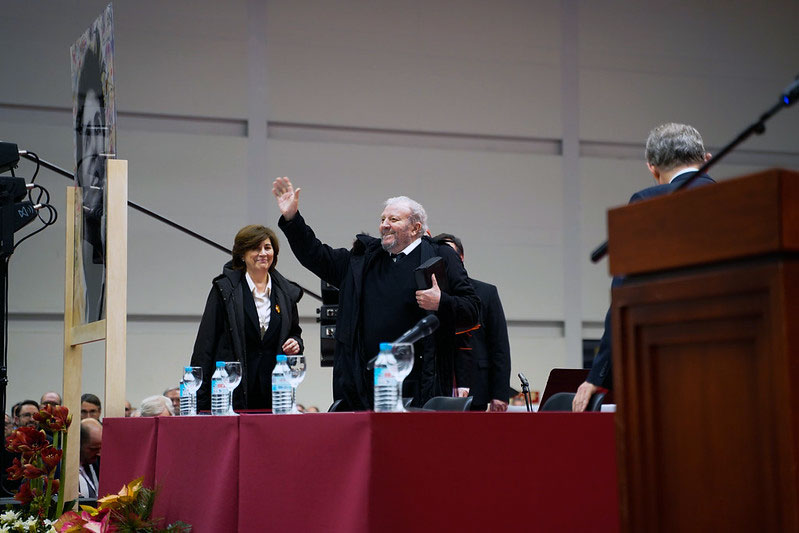
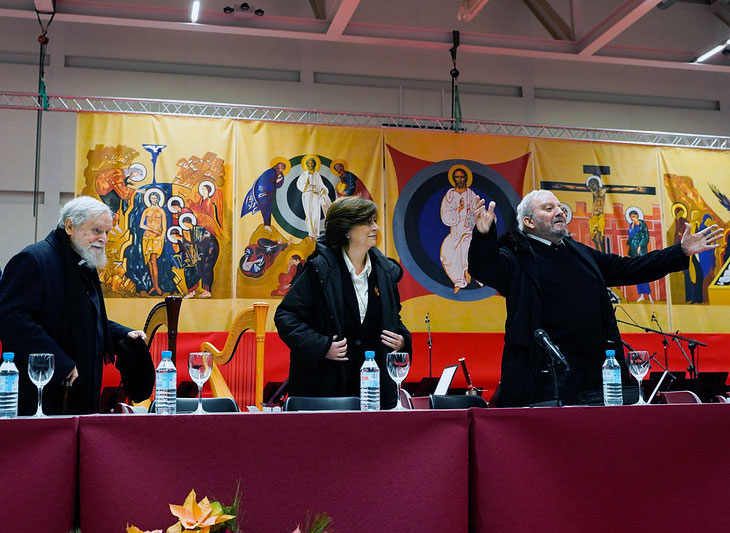
When it seemed that everything was pointing to her departure for the missions in India, after spending a year and a half in London, as was the custom in her Institute, learning English and completing her preparation for the missions, Carmen Hernández suffered what she called an “aerial detour” on her route of service to God: the superiors doubted her suitability to be admitted to perpetual vows and made her return to Spain. Carmen spent eight months waiting in one of the Missionary Sisters’ houses in Barcelona. During this time the Lord made her go through a very deep “kenosis”, in which all her illusion of being a missionary vanished; she says that Barcelona was like Mount Moriah, where she had to sacrifice her “Isaac” (her life project). She was comforted by going to the Marés Museum where “there are many Romanesque crucifixes where Christ is seen reigning on the cross”, not with the crown of thorns but with the crown of King, and she was invited to remain in that suffering, on that cross, because that is what Jesus Christ did.
But, above all, in this “Gethsemane” appeared, like an angel that consoled her, Father Pedro Farnés, the great liturgist. He transmitted to her the whole liturgical renewal, which at that time was beginning, with the rediscovery of the Easter Vigil and the power of the Eucharist, but not in a theoretical way, but “made flesh in herself” because of the circumstances of “suffering and death” she was going through, for if she was not admitted to the vows, where would she go? What was her place in the Church? For one thing was clear to her: the Lord was calling her to be a missionary! She had left everything for Him and for His Church! She learned that the “Memorial of the Death and Resurrection of Jesus Christ” is made present in the Eucharist and that she participates in it existentially, dying and rising with Him.
When it was confirmed that she was not admitted to perpetual vows, on August 28, 1962, her existential doubt became more acute. A small door opens because the Bishop of Oruro, in Bolivia, Bishop Jorge Manrique, invites her to go to his diocese to work among the poor miners. But she felt the need to go to the Holy Land, “the fifth Gospel”, and to know the land where her beloved Jesus walked. With very few resources, she went on pilgrimage to the Holy Places with a young Irish girl she met in London. The two of them traveled through the places of Israel, often walking, reading the Scriptures in the same places where the events took place; and they earned some money cleaning houses, both of Hebrews and Arabs. Curiously, in the Holy Land a great temptation appeared for Carmen, as she was invited to work at the Israel Institute of Technology, Technion, in Haifa, in a chemical research project, which she could have accepted, but she gave up because God’s call was much stronger. Many afternoons she would go to the rock of the Primacy of Peter, where the voice of Jesus resounds, “Do you love me?”. And Carmen would answer yes and ask the Lord “what was her place in the Church”. In August 1964 she returned to Spain and went to live in Palomeras Bajas, a shantytown on the outskirts of Madrid. There God had already prepared the meeting with Kiko Argüello, through one of Carmen’s sisters who knew him. An Ode of Solomon says that God has with each person “a design of ineffable art” [5], and so is the design that the Lord had prepared with Carmen Hernández: her irresistible call to evangelization, consolidated with her enormous theological, spiritual and liturgical preparation, joins the design prepared by God with Kiko Argüello: the presence of the suffering Christ among the poorest and the ability to gather and create small communities. To him, precisely, Our Lady had revealed five years earlier, on December 8, 1959: “We must create Christian communities like the Holy Family of Nazareth that live in humility, simplicity and praise, the other is Christ”. From this union of missions of Carmen Hernández and Kiko Argüello, the Neocatechumenal Way was born, encouraged from the beginning by the then Archbishop of Madrid, D. Casimiro Morcillo.
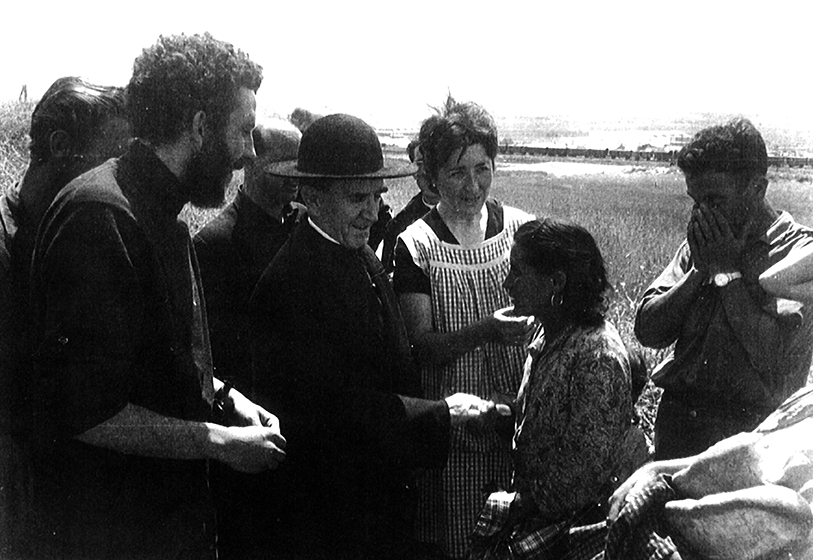
In this Neocatechumenal Way Carmen Hernández brings the Theology, the intuition, the research and study, and Kiko the realization, the “architecting” in a theological-catechetical and moral synthesis that attracts the most distant from the Church who lived in the shantytowns, and that at the same time can revitalize and revive the faith in the believers of the parishes; a faith sealed in the baptism received as children, but that many times did not mature to an adult stature of faith. Today, after this seed of the shantytowns spread through Kiko and Carmen and thousands of catechists formed by them, the Neocatechumenal Way is spread in more than 130 countries, with a total of 21,066 communities around the world, with a million and a half brothers and sisters, in 6,800 parishes. Kiko and Carmen, always accompanied by a priest, forming an itinerant team of evangelization, have been 52 years of constant evangelizing activity that has developed in many countries of the world. Carmen used to say: “This is not our work: it is God who carries it forward”. The initiators of the Way have spent more than fifty years, as St. Paul says, of “concern for all the churches” [6]: difficulties, failures, sufferings, frequent trips, meetings, living together, sleepless nights, without any pay or economic security, living on alms. We have the certainty, still subjective while awaiting the final judgment of the Church, that Carmen lived these years of her life in an evangelical activity to a heroic degree, without having “where to lay her head” [7]. Of course, this proclamation of the Gospel was also full of joys and consolations, seeing the action and power of the Lord: “I am with you always, to the end of the world” [8].
Curiously, in this whirlwind of evangelization, Carmen Hernandez, in her diaries, often notes moments of “emptiness”. After having had a very close experience of Jesus, and having witnessed God’s action in first person or seeing his action in the lives of her brothers and sisters, after having seen God so powerful in evangelization, she passes into periods of “emptiness”: Jesus, the Spouse, has gone, leaving her temporarily alone and she experiences “nothingness”. In her writings she often copies verses from St. John of the Cross, and expresses that nothing in the world attracts her, she has no desire to be surrounded by people, she thinks only of Him, to be alone with Him. She writes: “Finally, alone with you”. She wants to be spoken to about Him, so she constantly follows the activity of the Popes, listening to Vatican Radio or reading and rereading the countless books of Theology in her library.
Carmen Hernández knew that this Christian initiation of the Neocatechumenal Way could not be realized without some solid pillars that she lived and that she tried to instill in the brothers and sisters of the communities:
– The love and necessity of prayer: Carmen prayed all the hours of the Psalter, with true devotion and pleasure, she enjoyed praying, and it was the means to sanctify the day. Above all, she liked the Office of Readings, which she called the “Matutino”, which she did in the early morning, because she said that its psalms were “very existential”. She never missed an hour of the Liturgy of the Hours, even when traveling and on the road.
– Love for the sacraments, especially the Eucharist, which she partook of every day, and love for Penance. To these two sacraments Carmen dedicated many years of study with the best Catholic books and the best prepared theologians. She also reached the Hebrew roots of Christianity, studying the Hebrew feasts that Jesus Christ celebrated as a Jew and which are like sources of our sacraments: the Jewish Passover, the Day of Atonement (Yom Kippur) or Pentecost (Shavuot).
– Her love for Sacred Scripture, which she knew perfectly well, and with which she spent hours and hours, reading and re-reading the quotations, drawing out innumerable nuances and meanings. Carmen’s Bibles are underlined over and over again: it is impressive to see how “used and underlined” they are.
– Carmen Hernández was a constant student of the Catholic Faith, with the Fathers of the Church and all the Tradition of the Magisterium, her libraries have more than 4500 books of religion and hundreds of magazines of Theology. She listened to Vatican Radio daily, read L’Osservatore Romano (underlining and/or cutting out the most interesting articles) both the daily edition in Italian and the weekly edition in Spanish. I followed all the speeches of the Popes, mainly those of St. John Paul II and Benedict XVI.
She was always at Kiko Argüello’s side during these fifty years, encouraging him and helping him in the preparation and development of the meetings, gatherings, conviviality and also correcting him (“fraternal correction”) in what she saw necessary, especially so that he would not become proud when he saw too much success in this work of God, telling him that they were only “useless servants”. Many times she kept quiet (especially at the end, when she had less strength or because of illness), but she continued to encourage everyone, Kiko, the catechists and the brothers in the community. She was also a woman who spoke very freely.
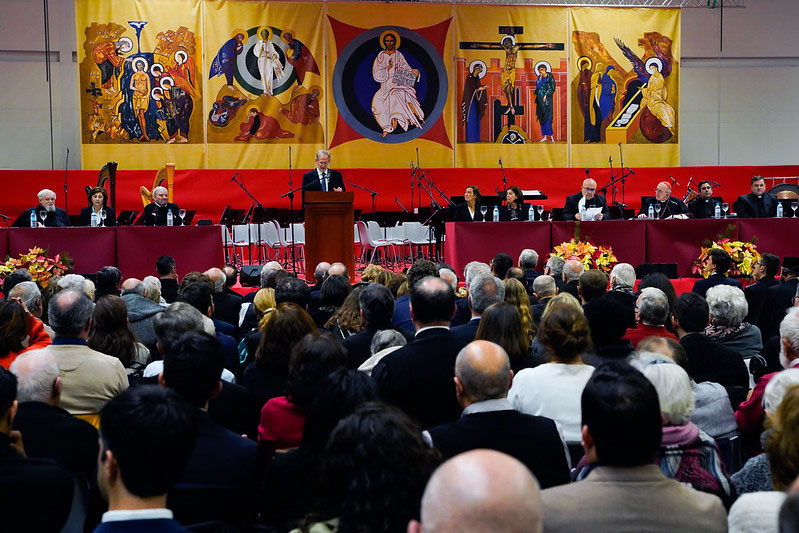
She had a special love for the “lost sheep”, that is, for those who were suffering, or for a brother in community who was going through difficult times or was in crisis; Carmen would call him and encourage him to meet Jesus Christ again in the sacraments, in the Word and in prayer, and she would tell him to ask for forgiveness. She remembered and knew the names and family and work situations of hundreds of brothers from the communities that they had directly catechized, as well as of the hundreds of itinerant catechists from the different evangelization teams.
During the last years of her illness, she followed, as far as she could, the hectic pace of world evangelization: travels, meetings, meetings, changes of location…. even though this meant more physical suffering and more pain, because of her heart disease, high blood pressure, leg pain (she had an ulcer that would not heal because of poor circulation), back pain (she had several broken vertebrae with very severe pain) and side pain (some broken ribs from several falls, which, although they later healed, were a cause of suffering). Many times she participated in the meetings following the audio from her room. Her death in Madrid, on July 19, 2016, was a quiet passage to eternal rest; she went “off” without any moment of resistance or rebellion, but with great peace and serenity.
Therefore, Your Most Reverend Eminence, WE BELIEVE AND CONSTITUTE that:
– Carmen Hernández has been able to live the Christian virtues to a heroic degree: faith, hope, charity, prudence, justice, fortitude, temperance, patience in suffering, piety, acceptance of God’s will, a very deep love for the Church and Jesus Christ, a very great love for prayer, for the hierarchy of the Church, with a great freedom in fraternal correction, and we believe we have enough proof of this, through her numerous personal writings, catechesis, letters and testimonies of the many people who have known her.
– There is a widespread fame of signs and favors among the people of God, that Carmen Hernandez intercedes before God for them, due to the numerous graces and favors that they have asked and continue to ask her daily. We have received more than 1500 graces from more than 70 different countries around the world.
– Numerous visits to the grave of Carmen Hernández (more than 50,000 people from about 70 different countries around the world have passed by), leaving in the books of condolences about 25,000 notes of thanks and requests.
– Thousands of faithful attend funeral and burial Masses, as well as anniversary Masses on July 19 each year, in many parts of the world.
-The great reception by the public of the books with the writings of Carmen Hernandez or her biography, published so far, and the great spiritual good that they say these books are doing.
-And all this fame of sanctity of Carmen Hernandez, which we have verified and confirmed, has appeared without any petition card, nor any web page, nor any special propaganda, so as not to artificially influence or generate this fame of sanctity.
For all these reasons, FIVE YEARS HAVE PASSED SINCE THE DEATH OF THE SERVANT OF GOD, according to the norms of the Causes of the Saints:
I REQUEST YOU, by means of this Supplex Libellus, to kindly consider the convenience of INITIATING THE CAUSE, about the life, virtues and fame of sanctity of the Servant of God María del Carmen Hernández Barrera, who died in your Archdiocese on July 19, 2016.
It is a grace that I wish to obtain from Your Excellency, whom God keep for many years.
Peace.
Carlos Metola Gómez Postulator of the diocesan phase
APPENDIX
As required by art. 37 of the Instruction Sanctorum Mater, I attach the following documents to the present Complaint:
- My procuratorial mandate as Postulator of the Cause;
- A biography of the Servant of God María del Carmen Hernández Barrera;
- The authentic and duplicate copies of the publications of the Servant of God; some are published writings already made public; and others are unpublished documents published “pro manuscript” for the internal use of the catechists of the Neocatechumenal Way.
- List of witnesses who can contribute to clarify the truth about the life, virtues and reputation of holiness of the Servant of God.
[1] Apostolic Constitution “Humanae Salutis”, 3. 25 December 1961.
[2] General Audience of Pope Paul VI, May 8, 1974, Vatican City.
[3] “Ogniqualvolta” letter to Msgr. Paul Josef Cordes, August 30, 1990.
[4] Cf. Luke 17,10.
[5] Odes of Solomon, 24.
[6] Cf. 2 Co 11,28.
[7] Cf. Mt 8,20
[8] Cf. Mt 28,20.
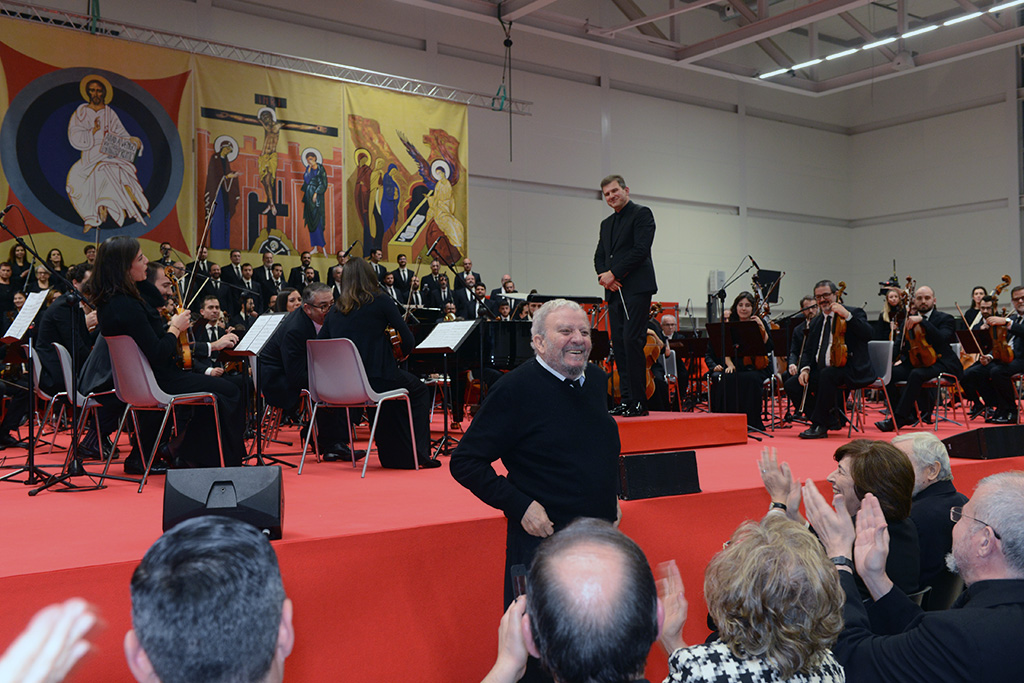
SYMPHONIC POEM AQUEDÁ
We are going to listen to a symphonic poem entitled “Aquedá“. The word Aquedá is a Hebrew word, which means “Bind me” and it is in the Targum Neofiti, which is a Hebrew commentary found in a library in Rome where the Hebrews were evangelized. And in that targum comes the translation of the passage of Abraham that describes the sacrifice of Isaac and adds what an angel tells him: “Come and see the faith on earth: a father who sacrifices his only son, and the beloved son who offers him his neck”.
I have set music to this text that deals with Isaac, an image of the humility of Christ, who being the Son of God humbled himself and became sin for us. This piece reflects the moment when Abraham was about to sacrifice his son, and staring at him, he puts him on the wood. And when he is about to kill him, Isaac says to him: “Bind me, bind me tightly, my father, lest through fear I resist and your sacrifice be invalid and we both be rejected”.
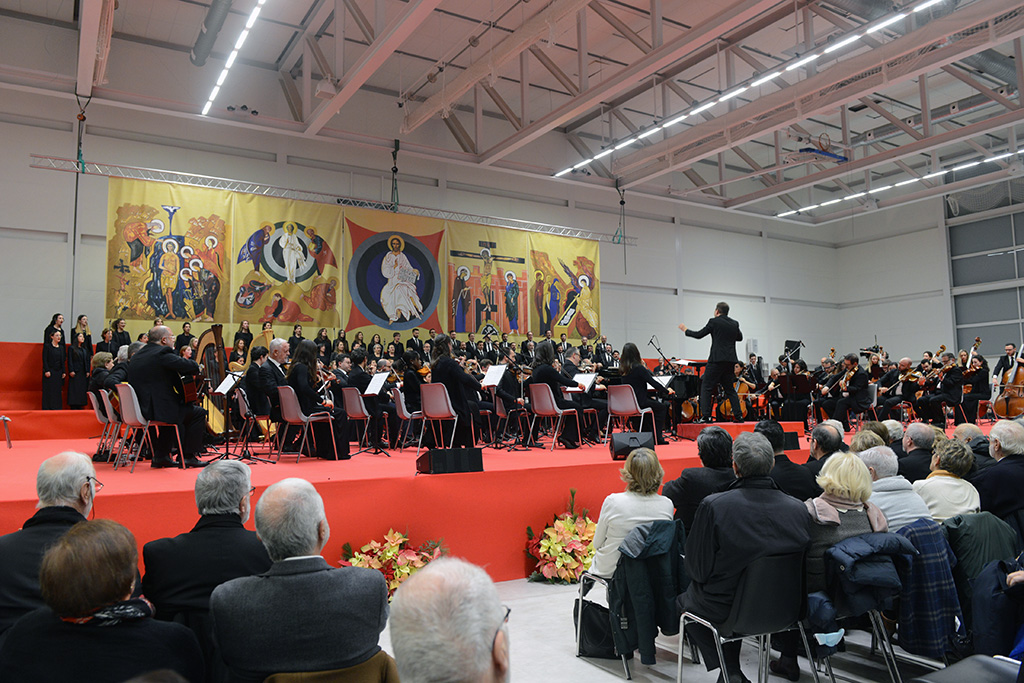
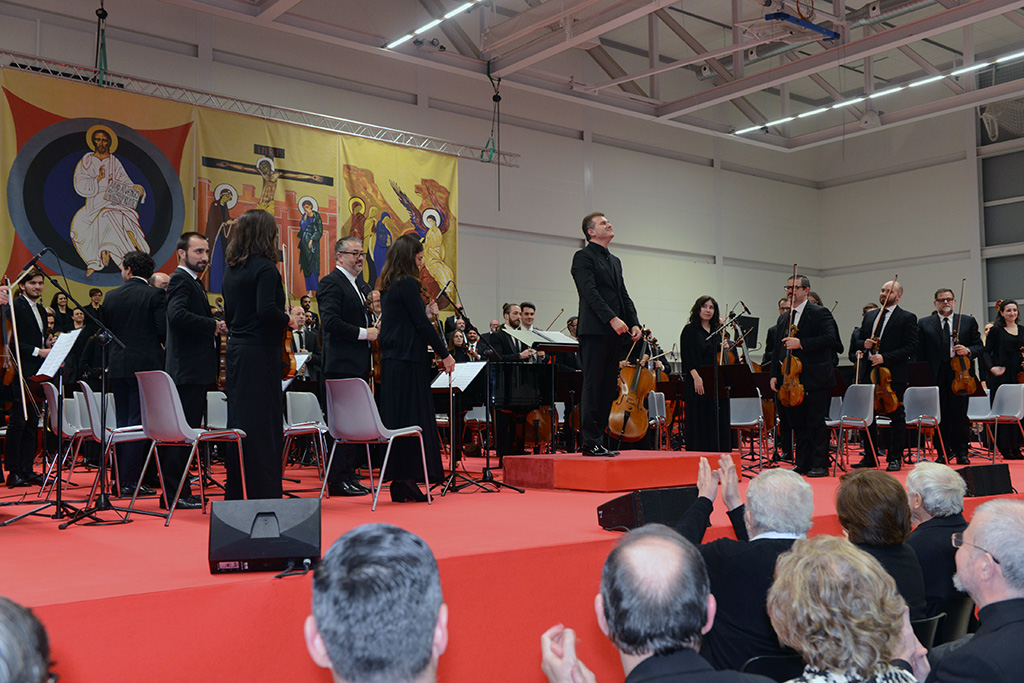
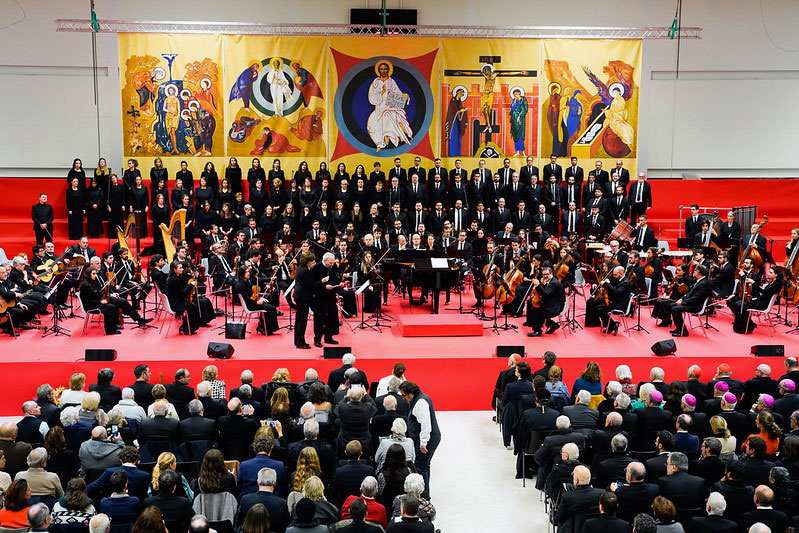
Because according to the ritual of the Temple, the lamb to be sacrificed had to be very tame. That is why they looked for among all the lambs -which is an image of the Immaculate Virgin- a lamb that was so meek that it had a little lamb that at the moment when it was going to be tied, it would not kick, because if it moves and kicks, the sacrifice is invalid. This is in the Talmud, in the rabbinical tradition, which prefigures the humility of Our Lord Jesus Christ, because Isaac is the image of Christ.
Carmen told many times that she lived in her flesh the experience of Abraham: the promise of being a missionary accompanied her throughout her childhood and youth, until her stay in Barcelona, which meant for her the ascent to Mount Moriah. Just as Abraham took Isaac to Mount Moriah to sacrifice, Carmen will take to sacrifice “her Isaac”, that is to say, her own vocation, her missionary life project, her desire to go to the missions.
Carmen said that it was the moment of the strongest trial of her life, of descent to the depths; but at the same time it was there where she saw the face of God, the Resurrection and Eternal Life.
SYMPHONIC POEM “DAUGHTERS OF JESRUSALEM”.
The second musical poem is entitled “Daughters of Jerusalem”, and it also takes us to Israel. What moved Carmen most about Jerusalem was to see that from the Mount of Olives she could glimpse the cross of Christ rising up. I have tried to put music to a fragment of The Passion according to St. Luke. Christ has been subjected to a torture that, according to Cicero, there has never been a greater torture in the world: the torture of the cross.
Imagine Jesus Christ crossing Jerusalem with the cross on his back, with his whole body swollen from the blows he had received with the Roman flagellum. On the Holy Shroud you can see the marks caused by the lashes that Jesus Christ had received, which caused his whole body to swell. Truly, to see Christ in this way, He looked like a monster, full of blood. Such was the appearance of Our Lord Jesus that while passing through a street there were some women who, seeing him, began to shout as they do in the East. Jesus stops and says to them, “Daughters of Jerusalem, do not weep for me, but weep for yourselves and for your children. For if you do this with the green wood, what will be done with the dry?”
These words of the Gospel are terrible: “if this is done to the green wood”; if this is done to the innocent, what will not be done to the truly guilty, which are we? What does Jesus Christ mean by this? That he has no choice but to go and save all humanity, all of us, from total suffering, from hell, from what the devil had prepared for the dry wood that is us. This word of the Gospel, so profound, so impressive, which gives meaning to the Passion and Death of Our Lord Jesus Christ, is what we are going to hear. I have tried a little to put it to music and I hope it can help you.
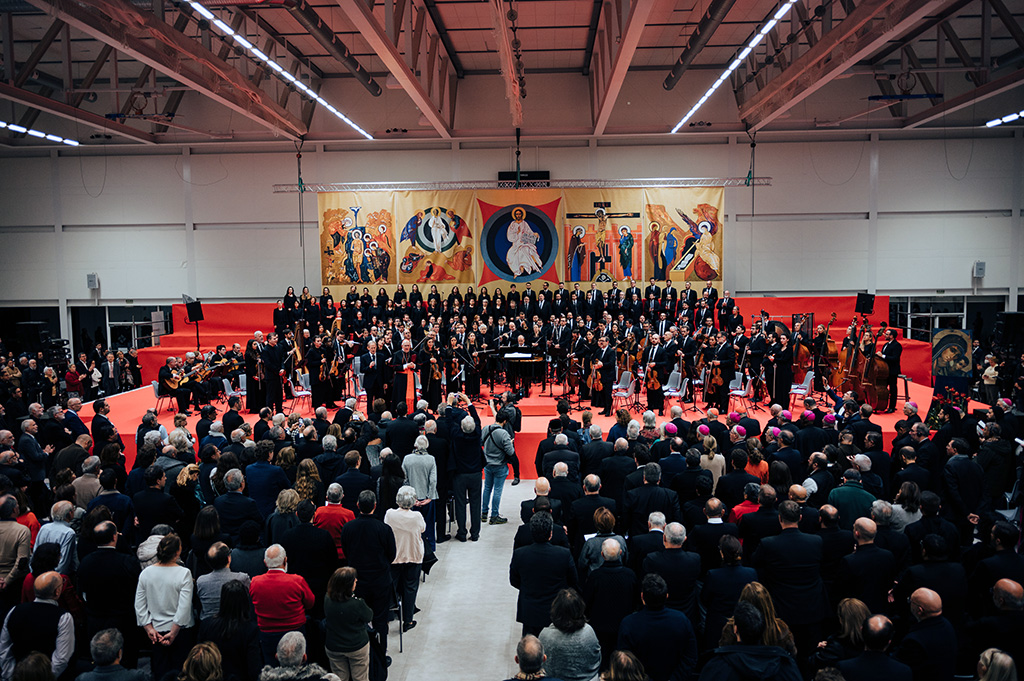
The Symphonic Orchestra and Choir of the Neocatechumenal Way is formed by teachers and musicians belonging to the Neocatechumenal Way.
Present today are:
- 94 musicians (instrumentalists and one pianist)
- 80 choir members
The orchestra is conducted by Tomáš Hanus:
He is from the Czech Republic; he is married; he has 8 children and belongs to the Neocatechumenal Way. In 1999 he won the international competition for orchestra conductors and since then he has conducted Philharmonic orchestras in several European countries, also in the Royal Theater of Madrid. He currently works at the Prague Philharmonic and is Music Director of the Welsh National Opera.
Carlos Osoro Sierra, Cardinal-Archbishop of Madrid
I greet with great affection the international team of the Neocatechumenal Way, Kiko, Father Mario and Ascensión, who are promoting the Cause of Canonization that we have just opened. I also greet fraternally all the cardinals, archbishops and bishops who have wanted to accompany us in this important moment, not only for the life of the Neocatechumenal Way, but for the life of the Church. I greet with affection all the priests and lay faithful, especially those of you who are on mission, and all those who are following this event on the Internet.
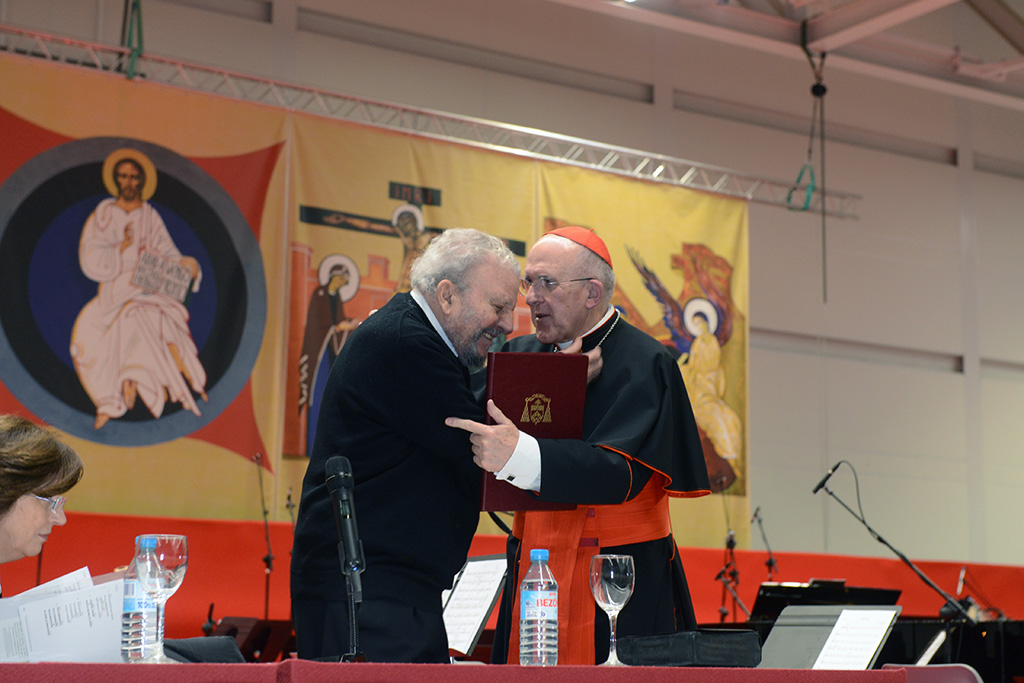
All of us who have known Carmen closely, as I have, especially when I was Archbishop of Valencia, know that she has been a particularly charismatic, courageous, passionate person, deeply in love with Jesus Christ. At times she was so passionate that she could seem politically incorrect. I would like to highlight three aspects of her that I think are especially necessary for our Church and our society:
First, her deep love for the Church, and especially for the Pope. Already as a young novice she wrote her thesis on “The need for prayer in the thought of Pius XII”. But it was with St. Paul VI that she began her close relationship with each and every Pope, a relationship that became especially intense with St. John Paul II, with Benedict XVI, and with Pope Francis. She loved the Pope, whoever he was, she did not belong to one Pope or the other. When she was already ill here in Madrid, Pope Francis called her on the phone. He told her to be calm, because weeds never die, and he told her he was going to give her a cigarette. Her relationship with the successor of Peter had reached that point of trust. But what lies beneath this closeness is a deep love for the Church, in a spirit of daughterly obedience. It is significant that she realizes that she has to stay with Kiko in the barracks when she sees the presence of Archbishop Morcillo.
Secondly, I would like to highlight her courage to speak fearlessly about the Gospel, truth and justice. Her words, which were sometimes very harsh, were born of the conviction that only the truth sets man free, and Christ is the truth. Carmen proclaimed the Gospel to the ends of the earth, following the missionary spirit that she saw born in her as a child. As we recalled in the song at the beginning of this act, she was able to say with her life: “My bonds are broken… I go everywhere”.
And thirdly, although we could say many things, I would like to emphasize the importance and dignity that Carmen gave to women, to their role in life, in society and in the Church. The beauty of the mother’s womb, where every man is formed, and where the Son of God was made flesh. The wonder of the life that is born within the woman. And also its eschatological dimension: the woman clothed with the sun who overcomes the serpent.
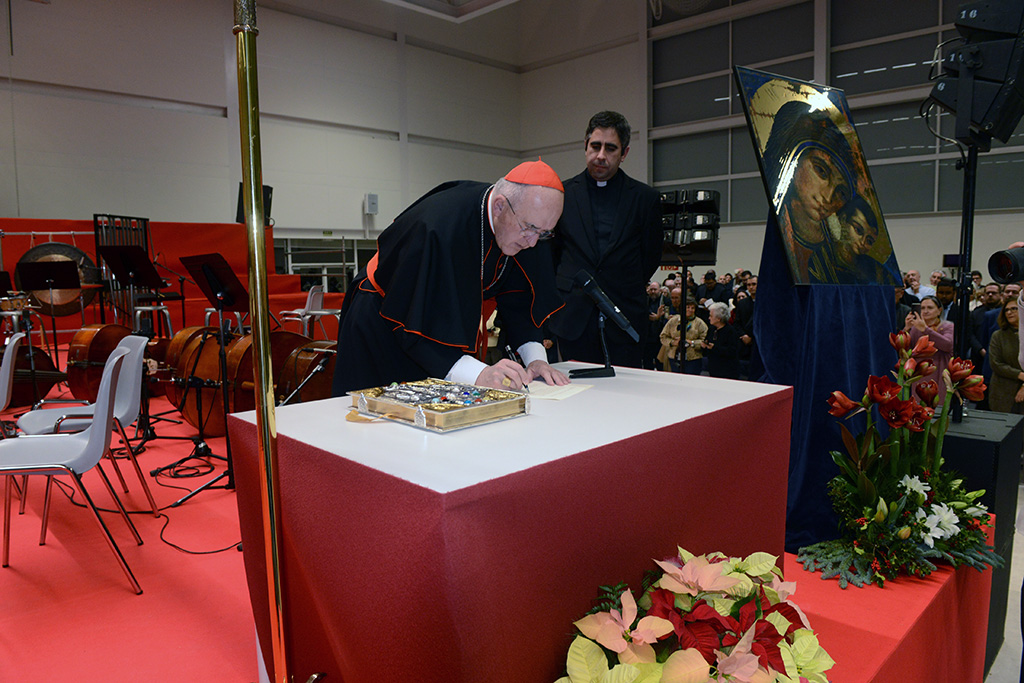
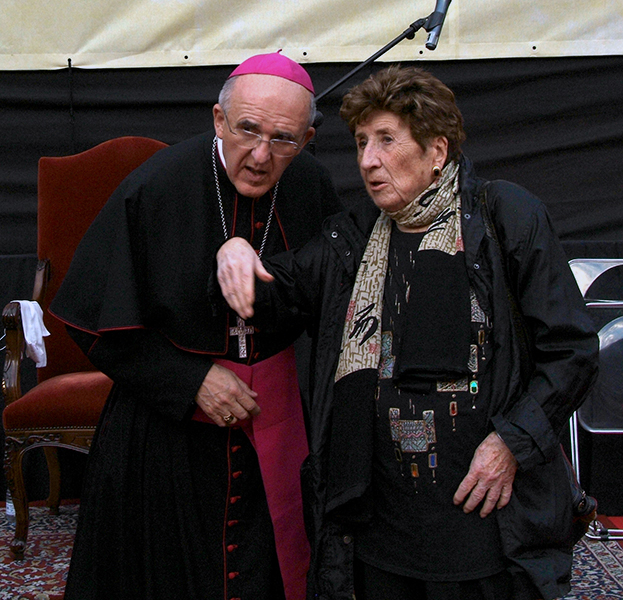
We must not forget, however, that this act is only the beginning of his cause of beatification, in which we will collect all the documents and all the testimonies that can help the Pope discern her life, her virtues and her reputation for holiness. It is the beginning of a long journey, in which we will rigorously and exhaustively study all the testimonies, both for and against this cause. I encourage you to ask for the intercession of the Servant of God Carmen Hernández. And I wish with all my heart that this cause will come to a successful conclusion, God willing.
